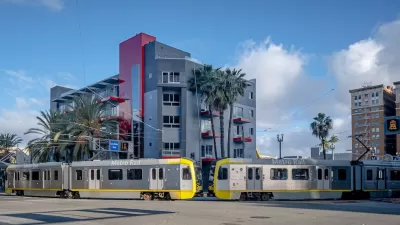Across America, TOD is seen as the solution for many of the problems that plague cities. But what if you could get the economic, environmental, and health benefits of transit-oriented development without the billions of dollars in rail investment?
To remedy the effects of several decades of sprawling development patterns, cities throughout the United States are pursuing the development of high-density pedestrian-friendly neighborhoods oriented around transit stations. "All that would encourage people to walk, bicycle and use transit instead of driving," says Marlys Harris. "Air would get cleaner, dependence on foreign oil would drop, and a thousand flowers would bloom."
"But here's the crucial question: Does TOD really decrease driving?"
"Studies have come down on both sides of the issue," she notes. "The latest, from Daniel G. Chatman, assistant professor of urban and regional planning at the University of California, Berkeley, made a pretty thorough investigation of the matter and concluded that people living in TOD areas did drive less, but — and here's the surprise — not because of the availability of transit."
"Instead of making multi-billion dollar investments in rail transit, Chatman argues, we may be able to reduce energy use and pollution just as much by creating incentives for higher-density mixed-use developments (incorporating housing, retail and offices) in certain areas while strictly limiting parking. Problem is, the local inconveniences of greater congestion and less parking would probably tick off neighbors and their elected representatives. Working all that out, he says,'is the planning puzzle that deserves our focused attention. The pursuit of rail-oriented development may be a distraction.'"
FULL STORY: Do we really need mass transit to limit our dependence on cars?

Trump Administration Could Effectively End Housing Voucher Program
Federal officials are eyeing major cuts to the Section 8 program that helps millions of low-income households pay rent.

Planetizen Federal Action Tracker
A weekly monitor of how Trump’s orders and actions are impacting planners and planning in America.

Ken Jennings Launches Transit Web Series
The Jeopardy champ wants you to ride public transit.

California Invests Additional $5M in Electric School Buses
The state wants to electrify all of its school bus fleets by 2035.

Austin Launches $2M Homelessness Prevention Fund
A new grant program from the city’s Homeless Strategy Office will fund rental assistance and supportive services.

Alabama School Forestry Initiative Brings Trees to Schoolyards
Trees can improve physical and mental health for students and commnity members.
Urban Design for Planners 1: Software Tools
This six-course series explores essential urban design concepts using open source software and equips planners with the tools they need to participate fully in the urban design process.
Planning for Universal Design
Learn the tools for implementing Universal Design in planning regulations.
Ada County Highway District
Clanton & Associates, Inc.
Jessamine County Fiscal Court
Institute for Housing and Urban Development Studies (IHS)
City of Grandview
Harvard GSD Executive Education
Toledo-Lucas County Plan Commissions
Salt Lake City
NYU Wagner Graduate School of Public Service





























